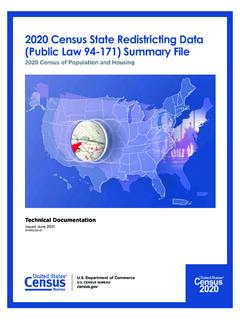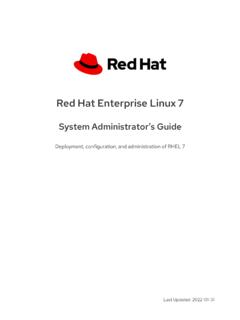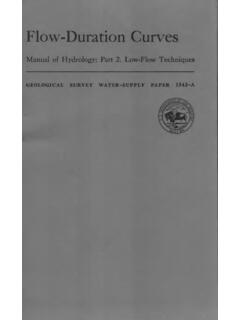Transcription of PuLP: A Linear Programming Toolkit for Python
1 PuLP: A Linear Programming Toolkit forPythonStuart Mitchell ,Stuart Mitchell Consulting,Michael O Sullivan,Iain DunningDepartment of Engineering Science, The University of Auckland, Auckland, New ZealandSeptember 5, 2011 AbstractThis paper introduces the PuLP library, an open source package that allows math-ematical programs to be described in the Python computer Programming lan-guage. PuLP is a high-level modelling library that leverages the power of thePython language and allows the user to create programs using expressions thatare natural to the Python language, avoiding special syntax and keywords wher-ever IntroductionPuLP is a library for the Python scripting language that enables users to describemathematical programs.
2 Python is a well-established and supported high levelprogramming language with an emphasis on rapid development, clarity of codeand syntax, and a simple object model. PuLP works entirely within the syntaxand natural idioms of the Python language by providing Python objects that rep-resent optimization problems and decision variables, and allowing constraints tobe expressed in a way that is very similar to the original mathematical expres-sion. To keep the syntax as simple and intuitive as possible, PuLP has focusedon supporting Linear and mixed-integer models. PuLP can easily be deployed onany system that has a Python interpreter, as it has no dependencies on any othersoftware packages. It supports a wide range of both commercial and open-sourcesolvers, and can be easily extended to support additional solvers.
3 Finally, it is Corresponding (S. Mitchell)available under a permissive open-source license that encourages and facilitatesthe use of PuLP inside other projects that need Linear optimisation Design and Features of PuLPSeveral factors were considered in the design of PuLP and in the selection ofPython as the language to Free, Open Source, PortableIt was desirable that PuLP be usable anywhere, whether it was as a straight-forward modelling and experimentation tool, or as part of a larger industrial ap-plication. This required that PuLP be affordable, easily licensed, and adaptableto different hardware and software environments. Python itself more than meetsthese requirements: it has a permissive open-source license and has implementa-tions available at no cost for a wide variety of platforms, both conventional andexotic.
4 PuLP builds on these strengths by also being free and licensed under thevery permissive MIT License[11]. It is written in pure Python code, creating nonew dependencies that may inhibit distribution or Interfacing with SolversMany mixed-integer Linear Programming (MILP) solvers are available, both com-merical ( CPLEX[1], Gurobi[2]) and open-source ( CBC[6]). PuLP takes amodular approach to solvers by handling the conversion of Python -PuLP expres-sions into raw numbers ( sparse matrix and vector representations of themodel) internally, and then exposing this data to a solver interface class. As theinterface to many solvers is similar, or can be handled by writing the model tothe standard LP or MPS file formats, base generic solver classes are included withPuLP in addition to specific interfaces to the currently popular solvers.
5 Thesegeneric solver classes can then be extended by users or the developers of newsolvers with minimal Syntax, Simplicity, StyleA formalised style of writing Python code[13], referred to as Pythonic code,has developed over the past 20 years of Python development. This style is wellestablished and focuses on readability and maintainability of code over clever manipulations that are more terse but are considered harmful to the maintain-ability of software projects. PuLP builds on this style by using the natural idiomsof Python Programming wherever possible. It does this by having very few spe-cial functions or keywords , to avoid polluting the namespace of the it provides two main objects (for a problem and for a variable) and thenuses Python s control structures and arithmetic operators (see section 3).
6 In con-trast to Pyomo (section 4), another Python -based modelling language, PuLP does2not allow users to create purely abstract models. While in a theoretical sense thisrestricts the user, we believe that abstract model construction is not needed for alarge number of approaches in dynamic, flexible modern languages like languages do not distinguish between data or functions until the code isrun, allowing users to still construct complex models in a pseudo-abstract fash-ion. This is demonstrated in the Wedding Planner example ( ), where a Pythonfunction is included in the objective Standard Library and PackagesOne of the strengths of the Python language is the extensive standard librarythat is available to every program that uses the Python interpreter.
7 The standardlibrary [4] includes hundreds of modules that allow the programmer to, for ex-ample: read data files and databases; fetch information from the Internet; manipulate numbers and dates; create graphical user addition to the Python standard library there are over 10,000 third-party pack-ages on The Python Package Index[3]. Many packages related to operations re-search can be found here, including PuLP [10], Coopr [7], Dippy [12], and Ya-posib [5], which are all projects in the COIN-OR Examples: PuLP in ActionIn this section we demonstrate how PuLP can be used to model two differentproblems. The first, the Capacitated Facility Location problem, demonstratesenough of PuLP to allow any MILP to be described.
8 The second, the WeddingPlanner problem, extends this by showing some more advanced features and ex-pressions that describe the model more Python SyntaxTo aid in the understanding of the examples, it is helpful to introduce some of therelevant language features of Python . Whitespace: Python uses indentation (with spaces or tabs) to indicate sub-sections of code. Variable declaration: Variables do have specific types ( string, number,object), but it is not necessary to pre-declare the variable types - the Pythoninterpreter will determine the type from the first use of the Dictionaries and Lists: These are two common data structures in are a simple container of items, much like arrays in many can change size at any time, can contain items of different types, andare one dimensional.
9 Dictionaries are another storage structure, where eachitem is associated with a key . This is sometimes called a map or associa-tive array in other languages. The key maybe be almost anything, as longas it is unique. For a more detailed look at the strengths and capabilities ofthese two structures, consult the Python documentation [14].myList = ['apple', 'orange', 'banana']myDict = {'apple':'red, 'orange':'orange', 'banana':'yellow}printmyList[0] % Displays "apple"printmyDict['apple'] % Displays "red" List comprehension: These are functional Programming devices used inPython to dynamically generate lists, and are very useful for generating lin-ear expressions like finding the sum of a set. Many examples are providedin the code below, but the general concept is to create a new list in place byfiltering, manipulating or combininb other lists.
10 For example, a list compre-hension that provides the even numbers between 1 and 9 is implementedwith the Python code:even = [iforiin[1,2,3,4,5,6,7,8,9]ifi%2 == 0]where we have use the modulo division operator % as our Capacitated Facility LocationThe Capacitated Facility Location problem determines where, amongstmloca-tions, to place facilities and assigns the production ofnproducts to these facilitiesin a way that (in this variant) minimises the wasted capacity of facilities. Eachproductj= 1, .. , nhas a production requirementrjand each facility has thesame capacityC. Extensions of this problem arise often in problems includingnetwork design and MILP formulation of this problem is as follows:minm i= i=1xij= 1, j= 1.













